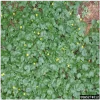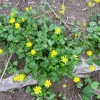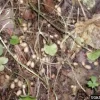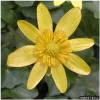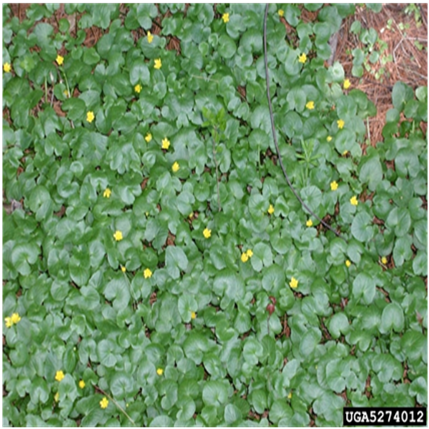X
CONTACT US
Great Lakes Center, SAMC 319
SUNY Buffalo State
1300 Elmwood Ave., Buffalo, NY 14222
wnyprism@buffalostate.edu
(716) 878.4708
SUBSCRIBE TO LISTSERV
FOLLOW US
CONTACT
Lesser Celandine
COMMON NAME:
Lesser celandineSCIENTIFIC NAME:
Ficaria vernaORIGIN:
EurasiaDESCRIPTION:
Lesser celandine is a low-growing, herbaceous perennial that has the ability to form extensive mats across the ground. It can be identified by its dark and shiny green, kidney-shaped leaves. The margin of the leaves are slightly toothed. The flowers are bright yellow, glossy and contain 8-12 petals. Under the soil, many finger-like tubers are produced on the root.HABITAT:
Lesser celandine prefers moist sandy soils, but is found in many other locations including low open woods, meadows, roadsides and disturbed sites.THREAT:
Lesser celandine emerges earlier than other native species, impacting species diversity. Lesser celandine is a particular threat to native spring ephemerals and on the native pollinators that rely on spring ephemerals for nectar and pollen.MANAGEMENT:
Control of lesser celandine may be difficult due to its persistence and underground tubers which can become unearthed and dispersed by animals, humans and flood events. Small infestations may be pulled by hand, but it is important to remove the entire plant including all bulbets and tubers. Herbicide treatments are more successful. Approved herbicides should be applied in early spring, which will minimize the impacts to native wildflowers.
WNY PRISM PRIORITY:
WNY PRISM Priority
Tier 4 - Local Control
ADDITIONAL RESOURCES:
There are no additional resources at this time.NYS Prohibited and Regulated Species - Part 575:
PATHWAYS OF INVASION:
Pathways
Lesser celandine was most likely introduced as an ornamental plant. Lesser celandine is spread through seeds and aerial bulbils.
Native Alternatives
Canadian anemone (Anemone canadensis)
Wild ginger (Asarum canadense)
Bunchberry (Cornus canadensis)
REGIONAL DISTRIBUTION:
Regional Distribution
Common


